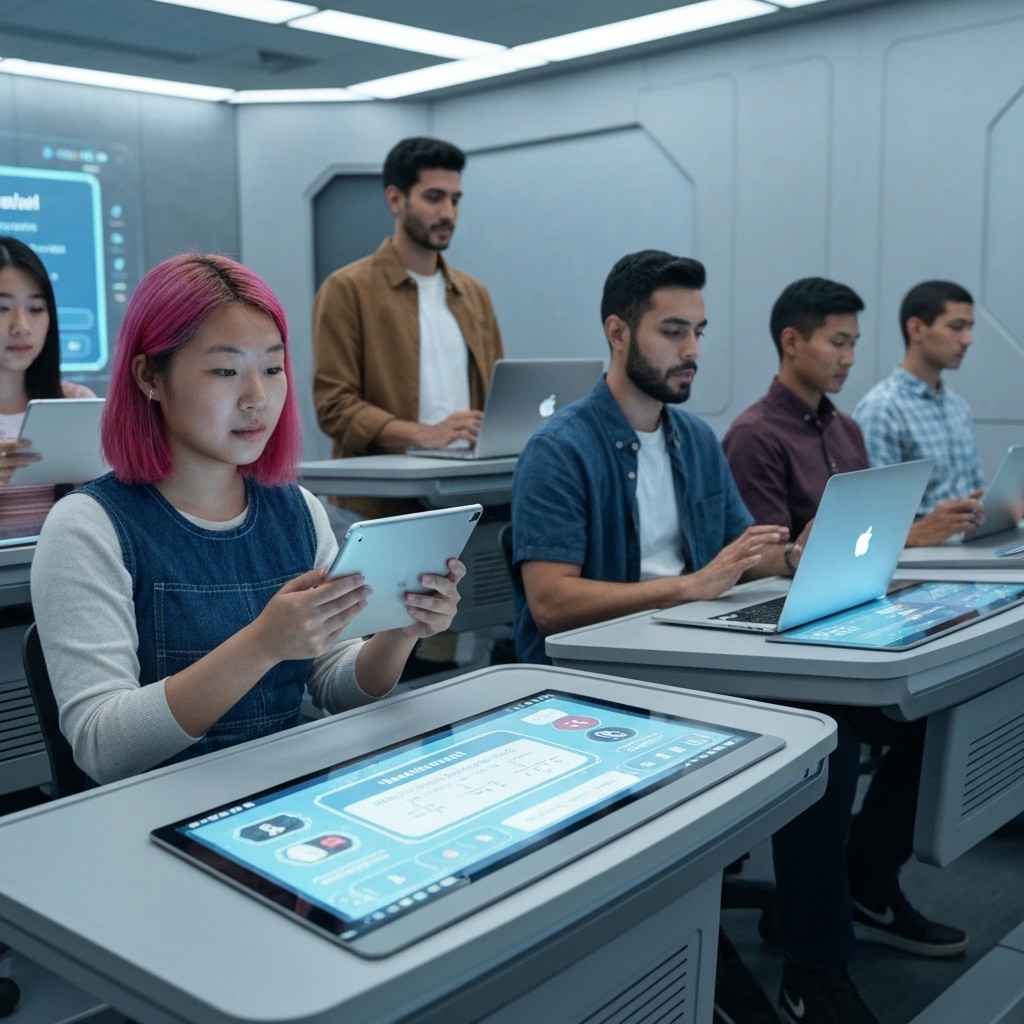How AI Is Changing Education in 2025: A New Era of Learning
How AI Is Changing Education in 2025: A New Era of Learning
Artificial Intelligence is increasingly becoming a cornerstone in modern education, enabling personalized learning experiences tailored to individual student needs. By analyzing vast amounts of data on student performance, AI systems can identify learning gaps and adapt content in real time, ensuring that each student progresses at their own pace. Platforms like Khan Academy already leverage AI to offer customized practice exercises and instructional videos, significantly improving engagement and outcomes. This shift from a one-size-fits-all model to adaptive learning environments marks a fundamental change in educational delivery.
Intelligent tutoring systems (ITS) are another breakthrough, offering students immediate and personalized feedback similar to what a human tutor would provide. These systems use natural language processing and machine learning to understand student queries and guide them through complex problem-solving processes. According to research published by the RAND Corporation, ITS can dramatically improve learning efficiency, particularly in STEM subjects. As these technologies become more sophisticated, they have the potential to supplement or even augment traditional classroom instruction, especially in under-resourced schools.
Beyond individual learning, AI is also streamlining administrative tasks for educators, from grading assignments to managing classroom schedules. Automated grading tools powered by AI can assess everything from multiple-choice tests to written essays, freeing up valuable time for teachers to focus on instruction and student interaction. The University of Michigan, for instance, has experimented with AI-driven tools to provide rapid feedback on student writing, enhancing both teaching efficiency and student learning. Such applications demonstrate how AI supports not just students but the entire educational ecosystem.
Looking ahead to 2025 and beyond, the integration of AI in education promises to deepen equity and access. With AI-powered platforms, learners in remote or underserved regions can access high-quality educational resources previously out of reach. Organizations like UNESCO are actively promoting ethical AI in education to ensure these technologies benefit all students, regardless of background. As policies and infrastructure evolve, AI’s role will likely expand, making lifelong, individualized learning a tangible reality for millions worldwide. For further insights into global AI initiatives in education, visit UNESCO’s AI in Education page.
Personalized Learning Pathways
One of the most transformative impacts of artificial intelligence in education is its capacity to deliver personalized learning experiences. By leveraging data on individual student performance, AI systems can identify strengths, weaknesses, and preferred learning styles. Platforms such as Khan Academy use adaptive algorithms to adjust content difficulty in real time, ensuring learners remain challenged but not overwhelmed.
These AI-driven tools analyze patterns in how students interact with material—such as response times, error trends, and engagement levels—to customize lesson plans and recommend targeted resources. This level of personalization was previously unattainable in traditional classroom settings due to scale and resource constraints. Research from institutions like MIT has demonstrated that personalized learning significantly improves academic outcomes, particularly in math and reading proficiency (EDUCAUSE Review).
Moreover, personalization extends beyond academics by accommodating diverse learning needs, including those of students with learning disabilities or those who are gifted. For example, AI-powered assistive technologies can provide real-time captioning, text-to-speech functionality, or simplified language versions. As a result, education becomes more inclusive and equitable, aligning with global goals for accessible learning set forth by organizations like UNESCO (UNESCO Education).
By continuously adapting to each learner’s evolving needs, AI fosters a dynamic educational environment where students progress at their own pace. This shift from a one-size-fits-all model to an individualized approach not only boosts comprehension and retention but also increases motivation and engagement. As these technologies mature, they hold the promise of reshaping education into a more responsive and student-centered experience.

Intelligent Tutoring Systems
AI-driven tutoring systems are transforming the way students access educational support, providing personalized learning experiences beyond the confines of traditional classrooms. By leveraging natural language processing and machine learning, these platforms can instantly answer student questions and break down complex topics into digestible explanations tailored to individual learning paces. Unlike static resources, AI tutors interact dynamically, simulating the responsiveness of a human tutor and helping reinforce understanding through immediate feedback. This real-time interaction is particularly beneficial for mastering challenging subjects such as mathematics and science.
One of the most advanced capabilities of these systems is their ability to adapt based on a student’s emotional state and engagement level. Using voice tone analysis and facial recognition technology, AI tutors can detect signs of frustration, confusion, or disengagement and adjust their approach accordingly—slowing down explanations, offering encouragement, or switching teaching strategies. This emotionally responsive tutoring fosters a more supportive learning environment, potentially increasing motivation and retention. Research in affective computing continues to refine these interactions, making AI tutors more empathetic and effective over time (Nature Scientific Reports).
Moreover, AI tutoring systems are increasingly accessible through mobile devices and online platforms, enabling learners from diverse backgrounds to receive high-quality academic support anytime and anywhere. Organizations like Khan Academy have begun integrating AI tools to enhance their offerings, demonstrating how scalable these solutions can be (Khan Academy). As advancements in artificial intelligence continue, these systems are expected to become even more intuitive, bridging educational gaps and supplementing classroom instruction with customized, data-driven insights.
Automating Administrative Tasks
Educators often face overwhelming workloads due to time-consuming administrative responsibilities such as grading, scheduling, and record-keeping. These tasks, while necessary, can detract from the core mission of teaching and student engagement. With advancements in artificial intelligence (AI), many of these routine duties are now being automated, significantly reducing the burden on teachers. For instance, AI-powered platforms can instantly grade multiple-choice assessments and are increasingly capable of evaluating essay responses using natural language processing techniques.
Tools like Gradescope leverage AI to streamline the grading process, allowing educators to apply consistent rubrics across large volumes of student work efficiently. Similarly, learning management systems integrated with AI features can automate attendance tracking, assignment reminders, and even parent communication, helping maintain organization without constant manual input. This shift not only increases accuracy but also ensures timely feedback for students, which is critical for effective learning.
By offloading repetitive administrative tasks, AI enables teachers to dedicate more time to personalized instruction, mentoring, and fostering classroom collaboration. Research from organizations like the Edutopia Foundation highlights that when teachers spend less time on paperwork, they report higher job satisfaction and improved student outcomes. Ultimately, AI does not replace the educator but enhances their capacity to focus on what matters most—their students.

Accessibility and Inclusion Through AI
Artificial intelligence is playing a transformative role in making education more accessible for learners with disabilities. By leveraging technologies such as speech-to-text and text-to-speech, AI helps students with hearing or visual impairments engage with digital content more effectively. For example, speech recognition tools can transcribe spoken lectures in real time, allowing deaf or hard-of-hearing students to follow along with classroom discussions. These advancements are supported by platforms like Google Accessibility, which integrates AI-driven features across its educational tools to enhance inclusivity.
Real-time captioning powered by AI is another breakthrough, providing immediate text translations of audio content during live lectures or video presentations. This capability not only benefits students with hearing loss but also supports those with auditory processing disorders or attention difficulties. Services such as Microsoft's Accessibility Features offer built-in captioning and voice navigation, enabling a smoother learning experience across devices.
Adaptive interfaces use AI to customize user experiences based on individual needs, adjusting font sizes, color contrasts, or navigation methods for students with physical or cognitive challenges. These personalizations ensure that learning platforms are usable by a wider range of students. Organizations like the Web Accessibility Initiative (WAI) provide guidelines that, when combined with AI, help developers create more inclusive educational environments.
By integrating these AI-powered tools into mainstream education, institutions can move toward truly equitable learning opportunities. As technology continues to evolve, the potential for AI to break down barriers in education grows, ensuring that all students—regardless of ability—can access, understand, and engage with academic content. Continued investment and awareness are essential to maximize the reach and effectiveness of these innovations.

Conclusion: Embracing the Future of Education
As artificial intelligence becomes increasingly embedded in educational environments, its capacity to personalize learning experiences is transforming traditional classrooms. AI-powered platforms can analyze individual student performance in real time, adapting content to meet diverse learning needs and paces. This level of customization supports differentiated instruction, enabling educators to address gaps in understanding more effectively. According to a report by the OECD, AI has the potential to enhance both teaching efficiency and student engagement when implemented thoughtfully.
Despite these advancements, significant challenges must be addressed to ensure responsible integration. Data privacy remains a top concern, as AI systems often rely on vast amounts of personal information to function optimally. Institutions must adopt robust data governance policies and comply with regulations such as the General Data Protection Regulation (GDPR) to protect student information. The UK Department for Education emphasizes the need for transparency and consent when deploying AI tools in schools.
Equitable access to AI-driven educational technologies is another critical issue. Without deliberate efforts, there is a risk of widening the digital divide between well-resourced and underserved communities. Policymakers and educators must work together to ensure that all students, regardless of socioeconomic background, can benefit from AI innovations. Initiatives like those promoted by UNESCO aim to foster inclusive AI in education through global collaboration and resource sharing (UNESCO AI in Education).
When guided by ethical principles and a commitment to equity, AI can help create learning environments that are more adaptive, efficient, and inclusive. By leveraging AI to support rather than replace human educators, institutions can focus on nurturing critical thinking, creativity, and social-emotional skills. The future of education lies not in choosing between technology and tradition, but in integrating the two to empower learners for the challenges of tomorrow.
